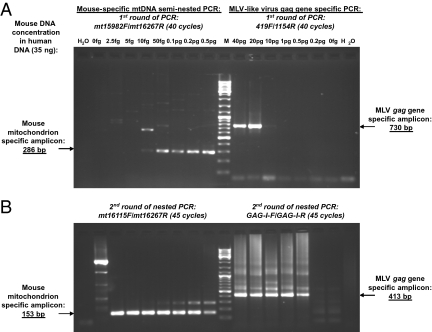Fig. 5.
Comparison of sensitivity in amplifying mouse DNA by the semi-nested PCR targeting mouse-specific mtDNA and by the nested PCR targeting MLV-like virus gag gene. Serial dilutions of mouse spleen DNA (from 40 pg to 2.5 fg) were spiked into 35 ng of total human PBMC DNA and compared in parallel for the mouse DNA detection sensitivity of the two PCR assays. (A) In the first round of the mtDNA-specific PCR assay, 10 fg or more of mouse DNA could be detected in the presence of 35 ng of human DNA by producing the 286-bp target product. In the first round of MLV gag gene nested PCR assay, 10 pg or more of mouse DNA could be detected in the presence of 35 ng of human DNA by producing the ∼730-bp target product. (B) In the second round of mouse-specific mtDNA semi-nested PCR, the 153-bp target amplicon could consistently be amplified from 2.5 fg of mouse DNA. In the second round of gag gene-specific nested PCR, the 413-bp target product could be amplified from 0.5 pg or more of mouse DNA. Lane 0 fg: 35 ng of human DNA without spiking any mouse DNA. Lane H2O: No DNA template. M: 100-bp DNA ladder mix. Primers and PCR cycle numbers used in each round of amplification for both of the assays are shown at the top of each gel.

